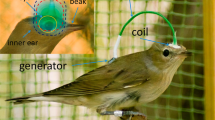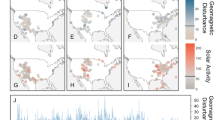Abstract
THE orientation of migratory birds is based on a complex of interacting compass mechanisms (the geomagnetic field, stars, patterns of skylight polarization and, perhaps, the Sun)1,2. A magnetic compass develops in birds that have never seen the sky3–8, but the preferred direction of magnetic orientation may be modified during the first three months of life by exposing naive birds to either the clear daytime or night sky under conditions in which magnetic directions differ substantially from true or geographic directions5–7,9. We hypothesized that celestial rotation, which indicates geographic directions both day and night, served as the calibrating reference7, and showed that a rotating pattern of artificial stars provided a sufficient stimulus to calibrate magnetic orientation in young Savannah sparrows (Passerculus sandwichensis)10. During daytime either the Sun's disc or patterns of polarized skylight could provide the reference to geographic compass directions11,12. Here we report that visual access to natural skylight polarization patterns is necessary for calibration of magnetic orientation during daylight.
This is a preview of subscription content, access via your institution
Access options
Subscribe to this journal
Receive 51 print issues and online access
$199.00 per year
only $3.90 per issue
Buy this article
- Purchase on Springer Link
- Instant access to full article PDF
Prices may be subject to local taxes which are calculated during checkout
Similar content being viewed by others
References
Wiltschko, W. & Wiltschko, R. in Orientation in Birds (ed. Berthold, P.) 16–37 (Birkhauser, Basel, 1991).
Able, K. P. Prog. Neurobiol. (in the press).
Able, K. P. in Orientation in Birds (ed. Berthold, P.) 166–179 (Birkhauser, Basel, 1991).
Wiltschko, W. & Gwinner, E. Naturwissenschaften 61, 406 (1974).
Bingman, V. P. Behaviour 87, 43–53 (1983).
Bingman, V. P., Beck, W. & Wiltschko, W. in Migration: Mechanisms and Adaptive Significance (ed. Rankin, M. A.) 544–552 (Marine Sci. Inst., Univ. Texas, Port Aransas, 1985).
Able, K. P. & Able, M. A. Anim. Behav. 39, 905–913 (1990).
Able, K. P. & Able, M. A. Ethology 93, 337–343 (1993).
Prinz, K. & Wiltschko, W. Anim. Behav. 44, 539–545 (1992).
Able, K. P. & Able, M. A. Nature 347, 378–380 (1990).
Brines, M. L. J. theor. Biol. 86, 507–512 (1980).
Phillips, J. B. & Waldvogel, J. A. in Avian Navigation (eds Papi, F. & Wallraff, H. G.) 190–202 (Springer, Berlin, 1982).
Bingman, V. P. Anim. Behav. 29, 962–963 (1981).
Moore, F. R. Anim. Behav. 28, 684–704 (1980).
Moore, F. R. Anim. Behav. 33, 657–663 (1985).
Able, K. P. & Able, M. A. Anim. Behav. 39, 1189–1198 (1990).
Emlen, S. T. & Emlen, J. T. Auk 83, 361–367 (1966).
Kirschvink, J. L. Bioelectromagnetics 13, 401–411 (1992).
Moore, F. R. & Phillips, J. B. Anim. Behav. 36, 1770–1778 (1988).
Batscheiet, E. Circular Statistics in Biology (Academic, New York, 1981).
Moore, F. R. Biol. Rev. 62, 65–86 (1987).
Helbig, A. J. Trends Ecol. Evol. 5, 365–367 (1990).
Kreithen, M. L. & Keeton, W. T. J. comp. Physiol. 89, 83–92 (1974).
Delius, J. D., Perchard, R. J. & Emmerton, J. J. comp. physiol. Psychol. 90, 560–571 (1976).
Coemans, M. A. J. M., Vos, J. J. & Nuboer, J. F. W. Naturwissenschaften 77, 138–142 (1990).
Able, K. P. Nature 299, 550–551 (1982).
Moore, F. R. Condor 88, 483–498 (1986).
Able K. P. J. exp. Biol. 141, 241–256 (1989).
Helbig, A. J. & Wiltschko, W. Naturwissenschaften 76, 227–229 (1989).
Helbig, A. J. Anim. Behav. 41, 313–322 (1991).
Helbig, A. J. Experientia 46, 755–758.
Able, K. P. in Animal Migration, Orientation, and Navigation (ed. Gauthreaux, S. A. Jr) 283–373 (Academic, New York, 1980).
Schmidt-Koenig, K., Ganzhorn, J. U. & Ranvaud, R. in Orientation in Birds (ed. Berthold, P.) 1–15 (Birkhauser, Basel, 1991).
Merritt, R., Purcell, C. & Stroink, G. Rev. Sci. Inst. 54, 879–882 (1983).
Cherry, J. D. & Able, K. P. Auk 103, 225–227 (1986).
Author information
Authors and Affiliations
Rights and permissions
About this article
Cite this article
Able, K., Able, M. Daytime calibration of magnetic orientation in a migratory bird requires a view of skylight polarization. Nature 364, 523–525 (1993). https://doi.org/10.1038/364523a0
Received:
Accepted:
Issue Date:
DOI: https://doi.org/10.1038/364523a0
This article is cited by
-
Why is it so difficult to study magnetic compass orientation in murine rodents?
Journal of Comparative Physiology A (2022)
-
Polarisation vision: overcoming challenges of working with a property of light we barely see
The Science of Nature (2018)
-
A novel autonomous real-time position method based on polarized light and geomagnetic field
Scientific Reports (2015)
-
Re-calibration of the magnetic compass in hand-raised European robins (Erithacus rubecula)
Scientific Reports (2015)
-
Orientation of the pied flycatcher Ficedula hypoleuca: cue-conflict experiments during spring migration
Behavioral Ecology and Sociobiology (2010)
Comments
By submitting a comment you agree to abide by our Terms and Community Guidelines. If you find something abusive or that does not comply with our terms or guidelines please flag it as inappropriate.



